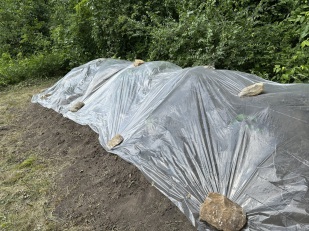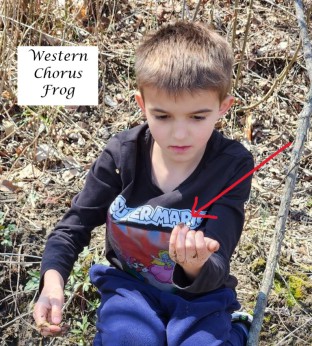
For Midwestern home gardeners and naturalists, just for fun! All my observations, photos, musings etc. on this website are centered on our 10 acres (named Shepherd Glen) in Jackson County Missouri, but I have found that observations (and frustrations) in our area translate pretty well throughout the Midwest.
Contact: askdrdoug@gmail.com
VISITORS OF DR. DOUG
What's Happening at the glen
October 16, 2023
Argh! The “Stick-tights” are back!
Although I have numerous nemeses, one oddly enough affects our laundry! Tick-trefoil (aka Sticktights; Beggar’s Lice; Desmodium paniculata) has pink to violet flowers like pea flowers, appearing in July through September. However, these pretty flowers are foreboding of the trouble the plants ultimately will cause.
The flowers develop into papery pods, that break off into 1-seeded segments that have natural Velcro! These plants tend to obnoxiously aggregate along the trails and the edge of our pond, just awaiting a ride to somewhere else.
I try to trim where I find them along the byways where I see them in flower, to avoid a cascade of them in late summer. However, it’s impossible to get them all, and as they turn into brown-colored pods, they are less conspicuous and difficult to avoid. These “sticky” seed pods annoyingly attach to any clothes rubbing against them. Although one can remove them by hand after the day’s work is done, it isn’t uncommon to miss a few, which end up in the laundry. It’s amazing where they end up, and even PJ’s have been known to harbor them!
July 1, 2023
First Try at Solarization
When we had the pond dredged along the edges, we had some of the soil piled up out of the way. I am always needing soil to fill in holes in the yard, in places where I take out plants, and replace soil in the garden.
However, I was worried about using much of it right away, for fear of inducing weeds etc. into the areas that I fill. I had read about using the sun (ergo solarization) to "cook" the soil and kill both the present weeds, and the weed seeds buried there.
I had read about solarization, so I read up a little more and thought I would try it; not much cost involved. They recommend covering the soil or plot area with heavy plastic of a thickness no less than 1 mil. I bought several big sheets and covered the pile, using local rocks to hold it down. They recommend 3 or 4 months before you should use it; so far so good.
June 10, 2023
Yellow is not my favorite color...but it's theirs!
It was time to paint the deck, even though the weather was hot and humid. After a while, I started being bothered by insects. It's tough to shoo them away, without spattering paint everywhere. I figured it was because I had gotten just a wee bit sweaty! However, I came to notice that the sweat bees circled the yellow handle on my paint roller....I was glad they weren't circling me!
I was still uncertain whether they were attracted to me or the yellow color, until a Frittillary butterfly landed on the handle too! I was now convinced that it wasn't me.
May 17, 2023
What are these holes?
If you wander near a pond or creek, you may run across these odd-looking holes? Many species of burrowing crayfish (also called crawdads) dig tunnels down to dampness or even to the water table.
It uses its legs and mouth to create pellets of mud as it digs its burrow. It places these “mudballs” up above the ground, into a mini volcano shape, with a neat hole at the top. They are often referred to as crawfish chimneys due to their upright, open construction. The crawfish chimneys connect down to a burrow (for laying eggs) that may reach 3 feet deep, some straight down and others with side tunnels extending different directions. We see them by our pond, so they are no bother to our lawn and a novelty to us.
May 11. 2023
Mysterious Patches in Lawn
Have you ever had the pictured mysterious patches of no grass in your lawn? Most times, they are in lawns that have a lawn service. What could they be? Since I do my own mowing (for now), I traverse the yard frequently and see a lot of things others might not. These are the result of mole damage. “Really” you say? Yes, when moles are digging, they often push up soil into mounds. Then the mowers come, they run over the mounds and compact the soil in this area, and it kills the grass. if you to avoid these unsightly spots, then control the moles….easier said than done!
May 3, 2023
Sweet Aroma of Honeysuckle
The honeysuckle is typically the first plant to show leaves in the spring and one of the last to go bare in the autumn. It is invasive, and its early green-up can shade developing undergrowth, especially wildflowers. Bush honeysuckles are large, upright, spreading shrubs with flowers that change from white to yellow, turning into vivid red berries. Birds eat the berries, and further spread this invasive shrub.
However, when they are in bloom, their sweet aroma wafts on the breeze wherever you walk. Only the fragrance of the Black Locust trees rivals the honeysuckle as an early spring sweet aroma.
April 5, 2023
Spring Choruses
Spring has a cacophony of sounds, including especially birds and frogs. I used to think that the early sweet frog sounds were from Spring Peepers since they were in "Spring". However, training at Burr Oak Woods Nature Center taught we that the early rasping, repeated preeep sound, similar to the sound of running a fingernail over the teeth of a comb, is actually the lovely sound of very tiny Western Chorus Frog.
This very small (3/4 to 1-1/2" long), secretive frog (see picture of our grandson holding this very tiny frog) is found near ponds, in meadows and along forest edges. It breeds in early spring in temporarily flooded fields and ditches. Later in the year they are seldom seen as they spend most of their time hiding in various underground hollows.
April 1, 2023
Wildflowers vs. Ephemerals
A wildflower is a flower that grows without any help from people, they grow naturally in their environment. Gardeners may plant wildflowers in their garden, but most wildflowers are native plants and grow in woods, meadows, wetlands – anywhere they are adapted to grow.
I grew up referring to all early native flowering plants, no matter how long they bloomed, as wildflowers. However, recently (at least to me) there has been a movement to call these ephemerals. Definition: ephemeral - lasting [i.e., blooming] for a very short time.
Spring ephemerals bloom in early spring before trees and shrubs leaf out, ergo before the sunlight is blocked from reaching the forest floor. As the name suggests, bloom time is often brief, so you don't want to miss the short interval of glorious blooms between snowmelt and leaf out. In just a few weeks, they grow, bloom, reproduce, and enter dormancy. The earliest "showy" ones on our property in central Missouri are Virginia Bluebells (pictured - Mertensia virginica) and Eastern Red Columbine (Aquilegia canadensis).
March 8, 2023
Elm buds bursting!
When the elm buds burst open, and the tiny unimpressive flowers form, it is a sure sign of Spring. Because of the lack of showiness of the flowers, you may first notice the grit of brown flower parts on nearby surfaces. We have a native elm overhanging the driveway, and it leaves a big enough mess that I make the effort to hose the driveway off, to not track this mess into the house. However, is a welcome task, since I always look forward to signs that the winter blues are almost gone, and the garden work needs to start!
February 28, 2023
Blue Bird House Cleaning
If you haven’t already done so, it’s time to clean out your blue bird houses awaiting new tenants. I spied a female (see picture) already checking out the house on the west side. I plan to start filling my prototype blue bird feeder with meal worms very soon. If interested in seeing it’s design, just let me know.
February 17, 2023
Nutty Squirrels!
We have mostly grey squirrels, but occasionally, we see a red squirrel. I hear so many complaints about squirrels bothering bird feeders; that has not been a problem for us. I’m convinced our resident red-tailed hawk keeps them under control. We do see evidence of them, like their nests high in the trees. However, other signs of them are a little more “squirrelly.” We have plenty of black walnut trees, which provide bountiful food for them. They seem to hide the nuts in some odd places like in-between logs in my wood pile and stuck in trees. They also seem to have chosen my little bridge as their nut cracking “station” (see picture). Since they don’t bother our feeder, and we don’t particularly like black walnuts, they can be as “squirrelly” as they want.
February 16, 2023
Cardinal Rule
Recently when we had a sudden snowstorm, we had a plethora of Northern cardinals congregating in the backyard trees, awaiting their turns at the feeder. We had never seen so many at one time; at least 15 beautiful males and probably just as many females (they are harder to see and count). Although some of the males were a little intimidating while feeding, we were amazed how “polite” most of of the cardinals were in taking turns at the feeder. (The poor house finches and chickadees had to sneak in for a bite whenever they could!) It is my understanding that male cardinals are very territorial against other encroaching males once spring rolls around and the breeding season starts. It will be interesting to see how many we see (or hear) after it warms up and we take down our feeder.
January 29, 2023
Deer Dilemma 2.0
It is common for deer (bucks) to rub their antlers on trunks of trees, especially ones that are 1 to 3 inches in diameter. [My guess is these trees still have some “spring” to them.] This usually happens in the fall or early winter, primarily to remove the velvet from their antlers, but also to mark their territories from other males. Regardless of the reason, if the damage is down to the cambium layer, the tree cannot heal, and will probably die within a year or two. So, by us encouraging deer on our property, we have seen numerous occasions of this. In most cases, the damaged saplings are “junk” volunteer trees, and we don’t really care. However, when they flirted with using our border Leland cypress trees, we were not happy. Well-placed fence posts have been a good deterrent. They can rub on all the “junk” trees they want, but leave our specimen trees alone!
January 26, 2023
Deer Me!
There has always been a dilemma for us on whether to encourage deer on our property or does it just invite trouble for our flowers and garden. Deer are beautiful and graceful animals and are enjoyable to watch. Since we have 10 acres, we decided to put up a deer feeder, but a fair distance from the house and garden. Our property is within city boundaries, so we don’t have to worry about drawing them toward nearby hunters. Within days, they found the feeder and we can see their activity from the house without binoculars. The jury will be out until gardening season on whether we made a good choice or not!













